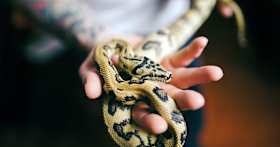What to Consider When Adopting a Reptile
Each reptile comes with different needs. (And no, they’re not low-maintenance pets.)
Each reptile comes with different needs. (And no, they’re not low-maintenance pets.)
by Alicia Kort, | June 10, 2025

Ani Dimi / Stocksy
Reptiles seem like they’d make pretty cool pets — it’s like bringing a zoo animal home or a direct descendant from dinosaurs. This can seem especially appealing if you’re a lifelong fan of snakes or lizards. And although adopting a reptile might fulfill one of your childhood dreams, reptiles have very specific needs that must be met, and often, they live for 15 to 30 years, if not longer. They’re a big commitment for such small creatures.
Although they might seem low-maintenance, many reptile species are not. Here’s a taste of what they need: A specialized habitat with precise temperature and humidity, exotic veterinary care, and unexpected ongoing costs, such as live prey. What one species of reptile needs differs vastly from another, so we’ll break down what you should take into consideration below before adopting one. Remember, a pet is a forever family member (even if they don’t have fur), so get your pet adoption checklist ready.
We spoke with Britany Graves, owner of Second-hand Serpents Reptile Rescue, to break down what you need to know before fully committing to your new pet.

Christopher Conde / Pexels
Let’s say that you have been wanting to adopt a snake since you were a kid, and that wish has not diminished at all now that you’re an adult with some extra income. You admire snakes, find them fascinating, and think that they’d make the best reptile pet. But before you adopt, make sure you’re ready to adopt a reptile. You should know all of the facts before adopting a snake, gecko, bearded dragon, turtle — or whichever reptile you’re considering.
Reptiles all have rigid sets of conditions that need to be met for them to thrive.
Although it might seem intuitive, potential reptile pet parents should try to remember that the bond with their reptile might be considerably different from that with a dog or cat. “So reptiles don't bond with their owners in the same sense that a dog or cat does. But they do learn to recognize us,” Graves says. “With a lot of interaction and handling, they learn to trust us. There are a few reptiles that do seem to be somewhat ‘affectionate’ and want to spend time with us, such as bearded dragons, tegus, and certain monitors.”
You might assume that, because reptiles are on the smaller side, they don’t live very long. In fact, the opposite is true. “When getting a reptile, you need to be prepared for a 10-plus year commitment,” Graves says. With the exception of chameleons, most reptiles live for over a decade.
Snakes, turtles, and tortoises can live up to 40 years (and in some cases, even longer). “Crested geckos can live 15 to 20 years, bearded dragons eight to 10 years, and ball pythons 20 to 30 [years], and that doesn’t even include tortoises who can live anywhere from 25 to 150 years,” Graves says. Some pet parents even specify in their will whom their reptile will be given to, if they pass away before their pet does.
Most reptile species are solitary creatures. They don’t want — or sometimes don’t like — interaction. “They don't need or enjoy having a friend to live with,” Graves notes. They’re perfectly content to bask in their enclosures all day. Most reptiles don’t play well with others. “They can be territorial, which can lead to one of them becoming injured or worse,” Graves says.
Sometimes, certain types of reptiles can live with other reptiles, but they have to be socialized early enough in their lives and be given enough space to thrive. “There are a few types of reptiles that can be housed together as long as they have a big enough habitat to live in. For example, certain frogs can be housed together as long as they are the same type,” Graves explains.
Reptiles can enjoy you holding them, but they need to be introduced to their pet parents at an early age, so they can get used to human interactions. And dogs, cats, and other family pets must be kept away from the reptile. The reptile or family pet might get one another sick.

These reptiles make for surprisingly sweet pets. Here’s how to prepare yourself for all the responsibilities involved with becoming a snake pet parent.
Reptiles don’t require much interaction or exercise, but their space should be big enough for them to roam around. “Bearded dragons, on the other hand, need to be fed daily, and they want to be handled. They need a decent amount of interaction and time out of their tank. They often will scratch at the front of their tanks, trying to get you to take them out,” Graves says.
But each species has different needs. For example, aquatic turtles need both a water feature and dry land in their enclosures. Multiple species also benefit from their environment being switched up occasionally or having toys in their enclosure.
Feeding a reptile is not as easy as picking up some kibble from your local grocery store and calling it a day. Lizards, for example, need live insects, and snakes need live or frozen mice. Pet parents of reptiles will need to stay on top of ensuring their pet has their food needs met. It won’t be as easy as ordering things online through Amazon.
Because reptiles are cold-blooded, they rely on temperature to keep their bodies running. Their enclosures will need to have heat, humidity controls, insulation, and some ventilation. Many require temperature gradients, too, so there are both warm and cool spots in their enclosures. If the temperature is not precisely kept, they could die. Some species will also need a UVB light, which can promote bone growth.
There are some challenges in having this type of pet, and we want to be transparent for anyone who is seriously considering bringing a reptile into their home.
Reptiles such as snakes, aquatic turtles, and many lizards do not like to be touched at all. Bearded dragons and leopard geckos are usually more amenable, but we don’t recommend getting a reptile with the assumption that you will be able to hold them.
“Vet care for reptiles is much different than cats and dogs,” Graves says. Some pet parents have trouble discerning if their dog or cat is sick, and this can be even more difficult to read if a reptile is ill. “It is a good idea for them to be seen by an exotic vet who has experience with reptiles. They can check for parasites and make sure overall the animal is healthy. Some of the common health concerns can be parasites, vitamin deficiencies, and respiratory infections, as well as some other ailments,” Graves adds.
Reptiles can suffer from metabolic bone disease, salmonella (more on that below), septicaemia (a blood infection), viral illnesses, and parasites. Most of this is treatable, but has to be caught early enough — and your pet will need to be taken to an exotic-animal vet.
“We often get the question, ‘Do they bite?’ Simple answer. Anything with a mouth can bite (including me),” Graves says with a chuckle. “The key is understanding how to handle the specific reptile and learning their body language. Does the animal look stressed? Did you scare them? Are they hungry? Did you just handle a rat before trying to take out the snake? Anytime I have been bitten, it has 100 percent been my fault.”
That is something that reptile pet parents should expect, which is also why reptiles need to be supervised around young children, who don’t know how to handle them. “A pet owner can go the reptile’s whole life without being bitten, but it can happen. The owner needs to be comfortable with that and understand how to avoid it,” Graves says.
Life with a reptile might be more hazardous than you’d expect. Some snakes and lizards are venomous, which is dangerous to humans for obvious reasons. Pet parents can get salmonella from reptiles, along with other transferable diseases, which can make humans very sick.
Because reptile pets require so many specific things, ranging from their enclosures to their food, the upkeep of a reptile can be costly. But the costs of reptile care can vary wildly, depending on the type of reptile you adopt. It can cost anywhere from $300 to $1,300 per year for small reptiles. The cost spikes considerably for exotic veterinary care, so reptile pet parents should keep an emergency vet fund. Setting up your reptile enclosure, especially if it’s on the large side, can be a big upfront cost — roughly $400 to $500. It’s a bit of a case of supply and demand: Reptiles aren’t the most popular pet, so it might be harder and more costly to track down what you need for them.
On the bright side, food itself isn’t usually too expensive. For example, feeding a snake mice a few times a week costs about $5 to $10 a week. Brittany provides a few more examples, such as for Geckos, food costs could be as little as $5 per month, whereas it could be up to $80 a month for bearded dragons.
The price for reptile adoption usually varies based on the size of the reptile. Small reptiles can cost $10 to $15, while larger reptiles, such as bearded dragons and tortoises, can cost upwards of $40.
The easiest way to adopt a reptile near you is through sites such as Adopt a Pet, where you can see available reptiles in your area from both individuals and rescues. You can also call your local animal shelter or rescue to ask if they have adoptable reptiles, though you might need to cast a wider net in terms of location to find them.
The chances are higher than you would hope, unfortunately. The majority of reptiles carry salmonella in their digestive tracts and feces. It’s extremely important for reptile parents to wash their hands after they handle their pet or clean out their enclosure. Pet parents over the age of 65, with children under the age of 5, or with weakened immune systems are more likely to become ill from salmonella, according to the CDC.
The leopard gecko is the best beginner reptile pet because they generally enjoy interacting with people and is low-maintenance. “I feel leopard geckos are the best for beginners because their diet consists of only bugs, and they do not need as high temperatures as a bearded dragon. They also don’t need daily handling. Although bearded dragons are fun because they are more interactive. But they need high temps and their diet requires a bit more effort,” Graves says.
“They absolutely can! The important thing is that the parents are prepared to take care of the animal,” Graves enthuses. “As a rescue, we take in so many reptiles because a child lost interest or didn’t take proper care of them. Having a pet is a great way to learn responsibility, but in the end, the parent has to know it is their job to ensure the health and safety of the pet. And they need to understand it is a long-term commitment.”
“Adoption Fees | Frederick County MD - Official Website.” Frederickcountymd.gov, 2023, www.frederickcountymd.gov/5892/Adoption-Fees.
“Article · 311 Service Portal.” Southbendin.gov, 2025, 311.southbendin.gov/knowledgecenter/article/?id=KA-04739.
Bottekaa. “Which Reptile Is Right for You? - Kinzey’s Pets.” Kinzey’s Pets, 11 Nov. 2024, buzz.uni.edu/kinzeyspets/which-reptile-is-right-for-you.
Corkery, Liz. “Care and Use of Reptiles.” Safety Services, 18 Feb. 2020, safetyservices.ucdavis.edu/units/occupational-health/surveillance-system/zoonotic-diseases/reptiles.
“Reptile Basics | Pets 4 Life.” U.osu.edu, u.osu.edu/pets4life/pet-care-basics/reptiles.
“Reptiles 101: Adopting with Care | Cummings School of Veterinary Medicine.” Tufts.edu, 21 Oct. 2021, vet.tufts.edu/news-events/news/reptiles-101-adopting-care.
“Your Reptile’s Proper Diet, Environment.” Veterinary Medicine at Illinois, vetmed.illinois.edu/pet-health-columns/pet-reptile-environment-diet.
Second-hand Serpents Reptile Rescue. “Second-Hand Serpents Reptile Rescue.” Second-Hand Serpents Reptile Rescue, 2025, secondhandserpentsreptilerescue.com/. Accessed 10 June 2025.

Alicia Kort is a writer and editor living in Brooklyn. She’s currently the senior commerce editor at Apartment Therapy. She’s been published in StyleCaster, Electric Literature, Newsweek, Interview, Brooklyn magazine and more. In her free time, she runs, reads, and spends time with her dog-nieces, Maya and Lady, and her cat-niece, Pepper.

Adoption Advice

Adoption Advice

Adoption Advice

Adoption Advice
It’s a big decision, so check these boxes before you sign on the dotted line.

Shelters & Rescue
Inside all the safeguards, limitations, and obstacles of the state and federal laws aimed at protecting animals — and how this may affect you.

Adoption Advice
Adopting a pet is a process that factors in everything from your age to living situation. Here’s what you need to know.

Shelters & Rescue
Shelters always need a variety of volunteers — and you offer more helpful skills than you realize.

Adoption Advice
Are you finalizing a new pet’s adoption? Learn everything you need to know about pet adoption paperwork.

Shelters & Rescue